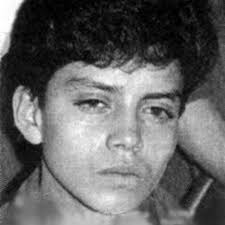
1976 - 1996
Juan Fernando Hermosa Suárez
Summary
Name:
Juan Fernando Hermosa SuárezNickname:
Niño del Terror (Child of Terror)Years Active:
1991 - 1992Birth:
February 28, 1976Status:
DeceasedClass:
Serial KillerVictims:
22Method:
ShootingDeath:
February 28, 1996Nationality:
Ecuador
1976 - 1996
Juan Fernando Hermosa Suárez
Summary: Serial Killer
Name:
Juan Fernando Hermosa SuárezNickname:
Niño del Terror (Child of Terror)Status:
DeceasedVictims:
22Method:
ShootingNationality:
EcuadorBirth:
February 28, 1976Death:
February 28, 1996Years Active:
1991 - 1992bio
Juan Fernando Hermosa Suárez was born on February 28, 1976, in Clemente Baquerizo, Los Ríos Province, Ecuador. He was adopted by Olivo Hermosa Fonseca and Zoila Amada Suárez Mejía, and the family relocated to a densely populated neighborhood in northern Quito. Raised mostly by his adoptive mother, who was deaf and afflicted with arthritis, Juan often lacked supervision. His adoptive father was frequently absent due to business activities in Sucumbíos Province.
By age 15, Hermosa was already deep in street culture, leading a group of ten other teens who frequented videogame arcades and discothèques around Quito. They became known for loitering in downtown areas, especially La Marín and Puente del Guambra.
murder story
On the night of November 22, 1991, Juan Fernando Hermosa committed his first known murder. After a night out at a discothèque, he and friends hailed a San Remo taxi in Quito. As they drove along 10 de Agosto Avenue, Hermosa pulled out a 9mm pistol and shot the driver in the head. The group then drove the car to the Los Chillos Valley, where they dumped the body. Just a week later, he returned to a hair salon operated by a transgender person named Charlie, someone he knew well. After being invited for drinks, Hermosa shot Charlie five times during an argument.
What followed was a spree of calculated killings. Over the course of four months, Hermosa murdered 22 people, including 8 taxi drivers, 11 homosexuals, a truck driver, his acquaintance, and two others. All the victims were shot, often during weekends. His crimes created mass panic across Quito, especially among taxi drivers and the LGBTQ+ community.
The Ecuadorian police, led by Mayor Fausto Terán Bustillos and the elite GIR (Grupo de Intervención y Rescate), launched a manhunt. Hermosa’s identity was exposed after several gang members were caught during an attempted robbery. On January 16, 1992, police stormed his home. A shootout followed in which his mother was tragically killed, shot 11 times. Hermosa attempted to flee through a back window but was captured.
He shocked authorities by revealing he was still a minor: “I want to make it clear that my name is Juan Fernando Hermosa Suárez and that on February 28, I will be 16 years old.” He claimed he didn’t intend to kill and said his victims ignored warnings to stay quiet, forcing him to shoot them. He also cited self-defense in some cases, including being threatened by a taxi driver with a revolver.
As a minor, Hermosa was sentenced to the maximum penalty allowed at the time—four years in the Virgilio Guerrero Rehabilitation Center. But his violent streak continued behind bars. Within 16 months, he had risen as a prison gang leader. With the help of his girlfriend Yadira, he smuggled in a pistol and used it to kill a police officer during a prison break on June 17, 1993, escaping with ten other juveniles.
He fled to Colombia, but illness led to his recapture. After serving his time, he was released in 1996. That same year, on his 20th birthday, he was found dead on the banks of the Aguarico River. He had been tortured, his face disfigured, his body cut with machetes, and riddled with bullets. Police identified him through documents found in his wallet. Witnesses said five hooded men were responsible for his killing—suggesting retribution, possibly linked to his victims' families or criminal enemies.